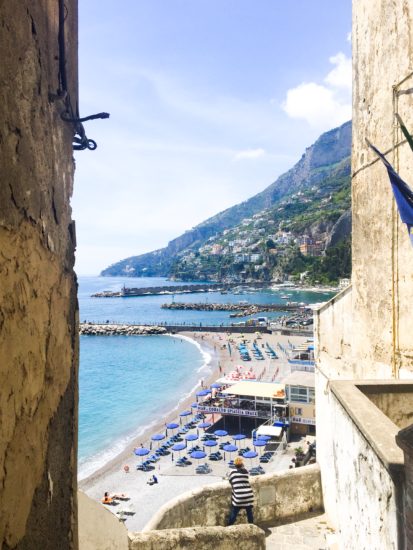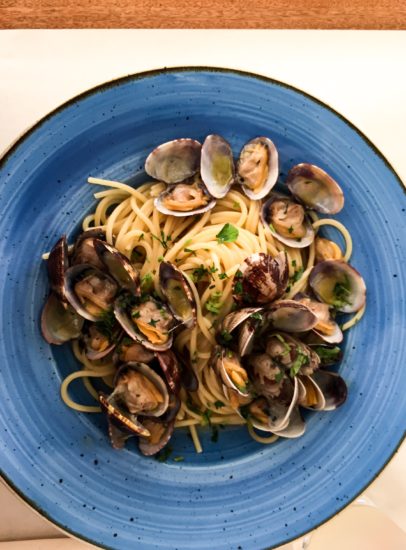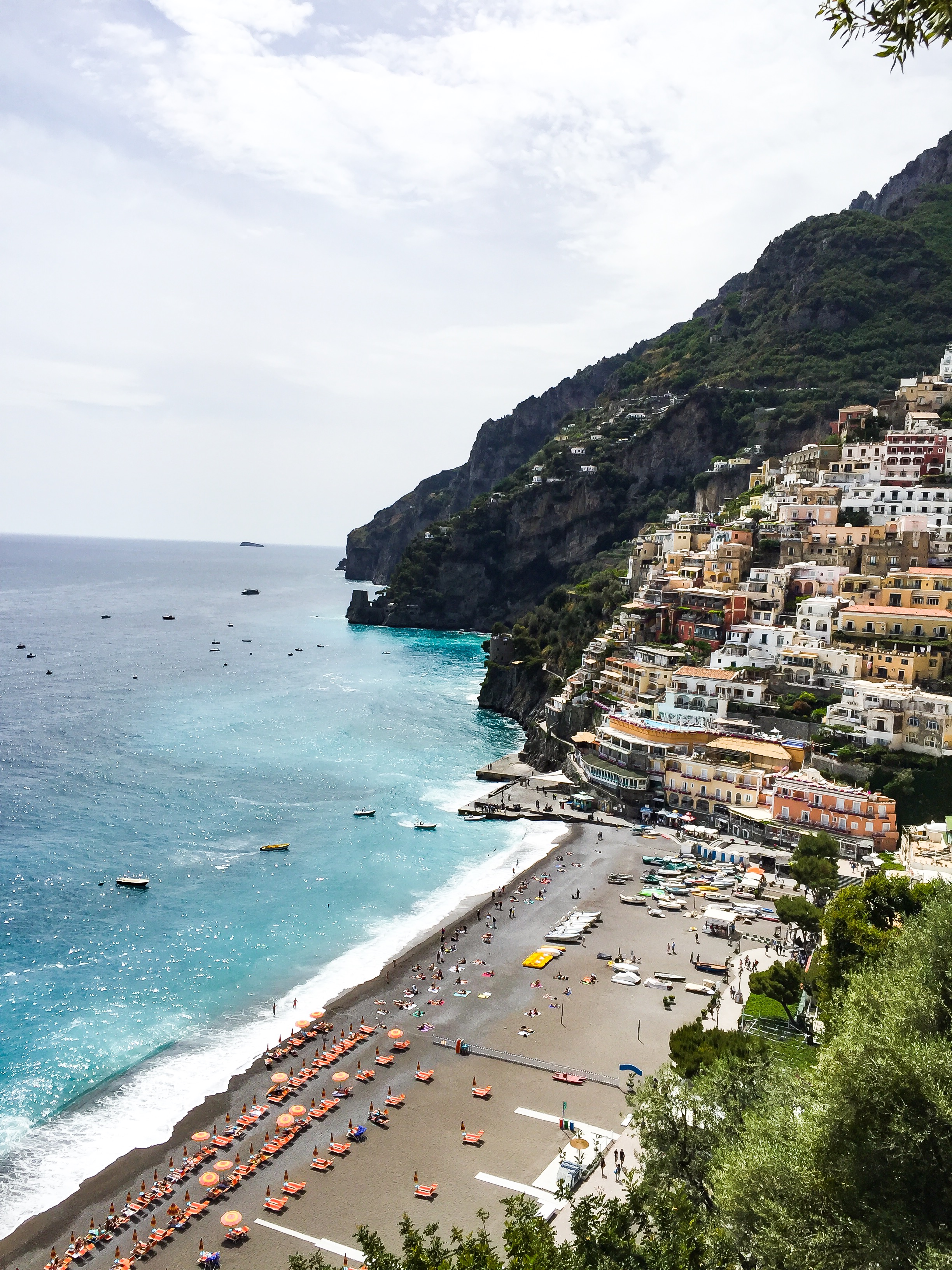This site is part of an affiliate sales network and receives compensation for sending traffic to partner sites, such as CreditCards.com. This compensation may impact how and where links appear on this site. This site does not include all financial companies or all available financial offers.
The Amalfi Coast is beautiful year round, and very expensive during the peak season. Yvonne, of Hello Wander World, who previously wrote about Barcelona, Rome, Culebra Island, Puerto Rico, Iceland, Costa Rica and Bangkok, recently went to the Amalfi Coast and here are her practical travel tips.
If you would like to write about your recent travel experiences on The Flight Deal, submit your pitch here.
====
You might know the Amalfi coast as one of the picturesque towns carved into the side of a coastal mountain. The sights are breathtaking, the culture is rich, and the lemons are sweet. It’s catered as a luxury destination with high end restaurants and stunning hotels, but it’s also very possible to make the trip more affordable. Be prepared to slow down your pace and really enjoy the sun and beauty. There’s no rush in this beautiful destination.

View of Amalfi from the alleyway of our bed & breakfast (which was 104 steps up) – Photo: (c) 2017 – Yvonne of Hello Wander World
How to Get There
The Amalfi coast is a great addition to longer Italian vacations, so it’s easy to reach from other cities. There are train and bus routes that connect many cities with Salerno and Sorrento. The train is faster and, if booked in advance, can be cheap (around €20 or less for one-way is common)! Pay attention to the time it takes to travel between the cities – there’s an express option most of the time that could save you about an hour of transportation time. The closest international airport is in Naples, which is about an hour and a half away, so a train ride would still be required. There’s also an option of hiring a private charter (these services will cost upwards of €400+ from Rome and €100+ from Naples).
Where to Stay
The Amalfi Coast spans over 6 towns all offering stunning views of the sea. Each town has its own character. Positano is the iconic, posh destination with many luxury hotels overlooking the sea. Amalfi also has an iconic seaside façade and is central with a major bus and ferry stop, proving to be a happy medium as far as tourist-friendly and authentic. The lodging here is more affordable than Positano. The most convenient towns are Sorrento, the far West of the coast, just South of Naples, and Salerno, the far East of the Coast. These two towns are the most direct connection to the rest of the country with trains and flights. Sorrento is the most touristy, offering the most hotels and English speaking restaurants. The smaller towns of Minori, Ravello, and Atrani offer a quieter stay with gorgeous gardens and authentic seaside Italian living. Ravello has an active live classical music scene. There aren’t many AirBnBs or hostels in the area. Most of your options will be hotels or bed & breakfasts. Although many of the hotels will be on the expensive side, you can find some wonderful bed & breakfasts with views for as low as €100/night. With most lodgings, you’ll pay a city tax of about €1.50/night.
How to Get Around the Coast
Another great aspect of the Amalfi Coast is that you get picture-worthy views at every turn, even when you’re just trying to get around. Get your walking shoes on because many hotels and b&bs are situated up along the cliffside, accessible only by steps. You’ll be working off the pasta and wine in no time. In the summer months, after Easter and into August, a ferry runs regularly between the towns of the coast. It doubles as a sea tour of the coast and a way to get to your destination for only €8 each way. Look for the schedule online and don’t buy your tickets more than a day in advance – trips may get cancelled due to choppy waters and weather. If the ferry gets cancelled or sailing isn’t your thing, there’s a bus system that connects all the towns and will take you many places for €1.50. Riding the bus is another adventure as the bus will drive quickly around the hairpin turns, hugging the cliff sides. Because of the easy public transportation, it’s not really necessary to rent your own car. Taxis are available at the bus stations as well. If you want a more personalized experience, you can hire a private driver for your time. Quotes are around €300 a day.

One of the best seafood pasta dishes I’ve ever had – enjoyed at a seaside restaurant in Positano – Photo: (c) 2017 – Yvonne of Hello Wander World
Food
Like the rest of Italy, food is a serious love. It’s to be enjoyed slowly and without waste. Coffee is an everyday staple, usually enjoyed at least twice a day (not in the way Americans drink a cup of joe, but rather a shot of tasty espresso). Seafood is obviously a specialty. You can’t go wrong with their seafood pastas and fresh clams. You’ll also be unable to avoid seeing citrus on the menus. Lemons grow to the size of hands and are used in many dishes. Even better is that lemon and seafood go great together. The Italians say real pizza comes from Naples and the proximity of the coast to Naples bodes well for the pizza culture. Italians eat late compared to Americans, with 1-2pm being lunchtime, 7-9pm being happy hour, and 9:30pm being dinnertime. This actually bodes well for Americans that eat earlier dinners, as most restaurants don’t become busy until later. Restaurants can be expensive so expect to spend at least €15/person for sit down meals. The good thing is there is no need to tip. Once done with the meal, waiters will only give you the check if you ask for it. They’re in no hurry to get rid of you so take your time to enjoy the meal.
Things to Do

Above the sea along the Path of the Gods – Photo: (c) 2017 – Yvonne of Hello Wander World
Path of the Gods
This hike is incredible and FREE! You can get to the trailhead by taking the bus to Bomerano and following the signs. It’s an easy hike with just a little bit of rock scrambling and incredible views at every turn. It should take about 2 hours to complete to the first exit point. At this point, you can hop on a bus or continue hiking for another hour to Positano.
Shopping
Each town has a center with restaurants and shops. Handmade leather sandals are a specialty good from the area, specifically in Positano and Amalfi. You can choose a minimalist strap or a bling-ed out strap and watch them sew and make the shoe right in front of you. Lemon products are also a very popular good you’ll see being sold in stores. They make everything from lemon candy, to soaps, to limoncello, to plates and decorations to adorn your kitchen with lemons. Ceramics are also a very popular souvenir.

A shot of Spiaggia Grande in Positano – Photo: (c) 2017 – Yvonne of Hello Wander World
Beach
Most of the beaches lining the Amalfi Coast are pebbly, not sandy, so wearing sandals is recommended. Entrance is usually free, but some beaches require you to rent a sun bed and/or umbrella for €7 – €13 each for the day. Each town boasts at least 1 beach to enjoy and they all offer different ambiances. The most well known beach is the Spiaggia Grande in Positano – the backdrop of the colorful houses makes you feel like an James Bond while sunbathing. The most lively beach is Amalfi’s Spiaggia Grande. Atrani Beach is one of the only sandy beaches along the coast, so it’s a popular choice for families with small children. You will also find smaller, hidden beaches as you work your way away from the center. You’ll find mainly locals and a quieter environment here.
Day Trip to Naples
If you’re interested in seeing more Italian history, you can head up North for a day trip to Naples to visit Mt. Vesuvius and the town that was once covered by its ashes, Pompeii. Naples sits about an hour and a half north and can be reached by train or by tour company.
Day Trip to Capri
A little out west of Sorrento sits the island of Capri. Known for the Blue Grotto and exquisite views, this small island is a very fun destination to explore. Ferries run from Positano and Sorrento daily during the summer season. One-way tickets cost about €21. There are also tours that will take you out and give you a history lesson on the island.

Great news for citrus fans – the lemons are huge! (Toes for scale) – Photo: (c) 2017 – Yvonne of Hello Wander World
Language
You can navigate the city with English, but know that only hotels and tourist-focused people will speak English. Using a few basic words in Italian to greet people goes a long way.
Hello: ciao
Thank you: grazie
You’re welcome: prego
The locals speak a Neapolitan dialect of Italian, so you may hear different pronunciations of words you know in standard Italian.
Best Time to Visit
The best time visit the Amalfi Coast is mid-April to May, when nature fully blooms, there are fewer crowds and the weather is at its best. Ferries and buses are running their full schedules and since peak season hasn’t started yet, hotel and restaurant prices aren’t as expensive. Even if there is rain, it won’t last. August, specifically, is a very crowded time for the coast because this is when most Italians vacation and flock to the beaches. You’ll be surrounded by locals and the town will be in full swing, but prices will be higher and space limited. In the winter, many hotels and restaurants close up so it’s very quiet. This is not a good time to be a tourist because there’s not much to do.
About The Author:
=====
To make sure you receive our latest deals, LIKE our The Flight Deal Facebook Page, follow us on Twitter @TheFlightDeal, Threads @TheFlightDeal or The Flight Deal WhatsApp channel or subscribe to The Flight Deal RSS Feed or Subscribe via Email (Once a Day)
The Flight Deal does not sell travel products or services. We provide you with information about third-party travel suppliers’ offers, and link you to their sites. The information posted by The Flight Deal is valid at the time of publication. However, we have no control over the suppliers, and we therefore do not warrant or guarantee that their offers will not change or become unavailable. Nor are we responsible for their products, services or site content. Please see their sites for their most up-to-date offer information and all applicable terms and conditions.
Sign up to receive The Flight Deal Daily DealsLetter, to stay up to date with the latest and greatest flight deals available.




Positano is a must, even with a slightly higher cost.
A driver from Naples is well worth the cost. The bus and train make several stops and often lack air conditioning.
Do a stop over at Pompeii, it’s super easy and well worth it. Download the Rick Steaves app and do your own tour.
“Restaurants can be expensive so expect to spend at least €15/person for sit down meals.”
Report from 1970s?
We just spent a week on the Amalfi Coast in early May, with our base camp being in Maiori, and it was fantastic. This town doesn’t get talked about much, but it has by far the best beach and is easier to get around due to being flat on the main drags. It seemed to have a lot of local Italian vacationers. Highlights include lemon grove tour in Amalfi, day trip to Capri, and the self guided Pompeii tour Jeremy mentioned. We are not tour guide people, so the Rick Steve’s app was the perfect way to navigate this huge area. At the end of the day, busses and ferries make it so easy to get around, it matters little where you stay if you plan on moving around from city to city because they are all great.
I visited Positano, Capri, & Sorrento from Sept 6th to the 15th. I used a shared transfer service to Positano and used the bus to go back to Naples. If I were to do it again, I would have no problem using the bus transportation. I thought it was very easy to use, cheap, and mine had AC. I used google flights to notify me of cheap rates and found some as cheap as $600 RT from the Midwest. Some with overnight stays in Spain. But I paid a little more not to do that. The walk of gods is a must. Make sure you take water and a snack if you take the longer route which I did. Capri also has some amazing hikes. I was able to eat for $8 to $20 each night, but did pay up for my hotels. It is definitely one of the most beautiful trips I have ever taken and would do it again.
It is beautiful but apart from the walks there is very little to do. Food is expensive and not that good. A 2 day stay at the most is sufficient